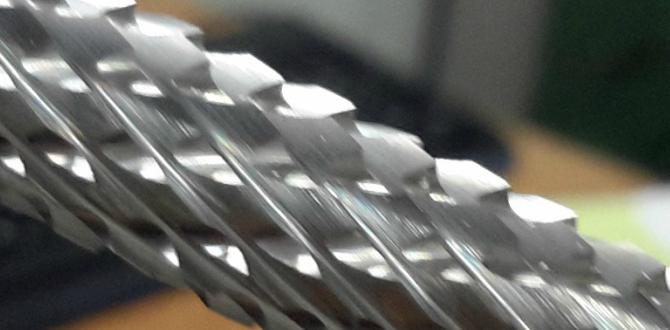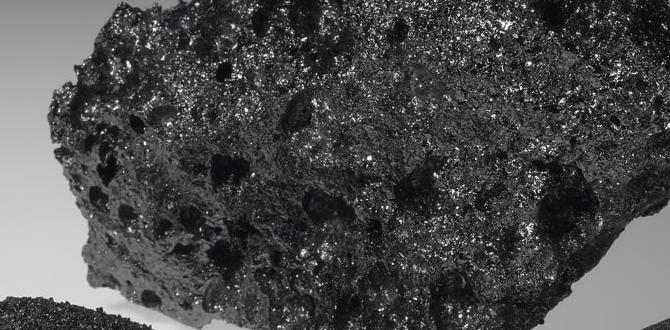Quick Summary:
A 35-degree Tialn ball nose end mill is a superior choice for 3D surfacing, particularly with tough materials like 316 stainless steel. Its coating and geometry allow for smoother finishes and longer tool life, making complex contouring more achievable for beginners.

Ever looked at those incredibly smooth, flowing surfaces on a CNC machined part and wondered how they achieve that perfect finish? You might be thinking it requires a super-specialized, incredibly expensive tool, or maybe even years of experience you don’t have yet. Well, you’re partly right – it does take the right tool and some know-how, but it’s more achievable than you think! For anyone diving into 3D surfacing, especially with challenging metals like grade 316 stainless steel, the right end mill makes all the difference. Today, we’re going to talk about a hero tool for this job: the 35-degree Tialn ball nose end mill. It’s a bit of a mouthful, but this tool is your secret weapon for creating those beautiful, complex shapes. Stick around, and I’ll break down exactly why it’s so good and how you can start using it for your own projects.
Why the 35-Degree Tialn Ball Nose End Mill is Your New Best Friend for 3D Surfacing
When you’re tasked with creating curved, flowing surfaces on your CNC machine, normal end mills just won’t cut it. They’re designed for flat bottoms and sharp corners. That’s where ball nose end mills come in. They have a rounded tip, kind of like a ball. This round tip is perfect for stepping across a surface, leaving a smooth transition between each pass – exactly what you need for organic shapes, molds, or complex prototypes.
Now, why specifically a 35-degree angle and the Tialn coating? This combination is a game-changer for several reasons, especially when dealing with materials that can be a real pain to machine, like 316 stainless steel.
Understanding Ball Nose End Mills
A ball nose end mill has a hemispherical tip. This means the cutting edge is essentially a segment of a sphere. When it cuts, it can create a concave or convex surface, depending on how you orient it and the cutting path. For 3D surfacing, you’re typically using it to gently shave away material, creating smooth contours and blended transitions.
We’ll focus on the ball nose aspect, but the “35-degree” refers to the helix angle of the flutes. This angle affects how the chip is cleared and the surface finish. A steeper helix (higher degree) can lead to a smoother finish but might require more rigidity. A shallower helix can be more aggressive but might chatter in certain materials.
The Magic of Tialn Coating
The “Tialn” coating — which stands for Titanium Aluminum Nitride — is applied to the carbide of the end mill. Think of it as a super-tough, heat-resistant shield for your cutting tool. Here’s why it’s so important for 3D surfacing and machining stainless steel:
- Extreme Hardness: Tialn is incredibly hard, which significantly increases the tool’s wear resistance. This means it can keep cutting precisely for longer, crucial for detailed surfacing jobs.
- Heat Resistance: Machining, especially stainless steel, generates a lot of heat. Tialn forms a ceramic-like layer that defends the tool from this heat, preventing it from softening and dulling quickly.
- Reduced Friction: The coating creates a smoother surface on the end mill, helping chips slide away more easily. This reduces friction, leading to less heat buildup and a better surface finish.
- Lubricity: While not as slick as some other coatings, Tialn offers a good balance of hardness and some inherent lubricity that aids in cutting.
For sticky, gummy materials like 316 stainless steel, which tends to work-harden and grab tools, a Tialn coating is almost essential. It allows the end mill to cut cleanly without excessive heat or built-up edge.
What About the 35-Degree Helix Angle?
The helix angle of an end mill’s flutes is the angle at which they spiral around the tool’s body. For ball nose end mills used in 3D surfacing, especially with tougher materials like stainless steel, a 35-degree helix angle is often a sweet spot. Here’s why:
- Chip Evacuation: A moderate helix angle like 35 degrees offers a good balance for clearing chips. Stainless steel can produce long, stringy chips that can get recut, causing poor finish and tool wear. The 35-degree angle helps lift and expel these chips effectively.
- Surface Finish: This angle contributes to a smoother cutting action. It helps reduce vibration and chatter, which are enemies of a good surface finish. For creating those seamless, flowing contours, minimizing vibration is key.
- Tool Strength: A very steep helix angle can sometimes weaken the core of the end mill. A 35-degree angle provides a good compromise between cutting efficiency and tool rigidity, making it less prone to breaking.
When you combine a ball nose shape with Tialn coating and a 35-degree helix, you get a tool that’s built for taking on the most demanding 3D surfacing tasks, especially on materials that would chew up and spit out lesser tools.
Applications for Your 35-Degree Tialn Ball Nose End Mill
This specialized end mill opens up a world of possibilities for your CNC projects. Its ability to create smooth, complex surfaces makes it ideal for a variety of applications. Here are a few common ones:
- Mold Making: From plastic injection molds to stamping dies, creating the intricate cavities and contours of a mold requires smooth, precise surfacing.
- Prototyping: When you need to create functional prototypes with complex aerodynamic or ergonomic shapes.
- Medical Implants: Devices like prosthetics or surgical tools often have very specific, organic shapes that need a high-quality finish.
- Aerospace Components: Turbine blades, impellers, and other parts with complex curves demand the precision and surface finish this type of end mill can provide.
- Artistic Sculptures and Jewelry: For creating intricate 3D artwork or custom jewelry pieces with flowing designs.
- Any Complex 3D Contour: If your design has curves, drafts, or blended transitions, this end mill is your go-to.
The 35-degree Tialn ball nose end mill is particularly well-suited for these applications when working with difficult-to-machine metals like 316 stainless steel, which you’ll often find in high-end or specialized parts.
Choosing the Right 35-Degree Tialn Ball Nose End Mill
Not all 35-degree Tialn ball nose end mills are created equal. When you’re selecting one for your specific needs, consider these factors:
Material Compatibility
While the Tialn coating is excellent for stainless steel, it’s also great for other steels, titanium, and even some high-temperature alloys. For softer materials like aluminum or plastics, you might not need such a robust coating, or a different geometry might be more efficient. However, if 316 stainless steel is your target, this tool is a fantastic choice.
Diameter
The diameter of your end mill will affect the types of features you can create and the cutting forces involved. Larger diameters are generally more rigid and can remove more material faster, but they are less suitable for fine details or tight corners. Smaller diameters are great for intricate work.
Number of Flutes
Ball nose end mills often come with two or four flutes.
- Two Flutes: Generally better for softer materials, plastics, and wood. They provide good chip clearance.
- Four Flutes: More common for harder materials like steels and stainless steels. They offer greater rigidity and can handle higher feed rates, but chip clearance can be more of a concern. For machining 316 stainless steel, a 2-flute end mill is often preferred to maximize chip evacuation and minimize clogging.
Coating Quality and Manufacturer Reputation
Tialn is a type of coating, but the application process, thickness, and quality can vary between manufacturers. Look for reputable tool brands known for their quality coatings and carbide substrates. A well-applied Tialn coating will be uniformly smooth and adhere strongly to the carbide.
Corner Radius (for Ball Nose)
While we’re talking about ball nose, remember that even a slight difference in the radius at the very tip can impact the surface finish. Most ball nose end mills are precision ground to a true radius. Ensure the radius is appropriate for the level of detail you need.
For 3D surfacing, particularly in 316 stainless steel, a 2-flute, 35-degree helix Tialn ball nose end mill from a trusted manufacturer is usually the best bet.
Setting Up Your CNC for 3D Surfacing with a 35-Degree Tialn Ball Nose End Mill
Getting your machine ready is just as important as choosing the right tool. Small adjustments can make a big difference in performance and tool life.
Workholding is Key
For 3D surfacing, especially with stainless steel, your workpiece needs to be absolutely secure. Any movement can ruin your surface finish or break the tool. Ensure your vise, clamps, or fixture is robust and properly tightened.
Tool Holder and Spindle Nose
Use a high-quality tool holder, like a hydraulic chuck or a shrink-fit holder, for the best runout (how true the tool spins). Minimal runout is critical for achieving a fine surface finish. A standard R8 collet might be okay for softer materials, but for stainless steel, better runout control is needed.
Spindle Speed and Feed Rate Considerations
This is where things can get a bit technical, but we’ll keep it simple. The goal is to find a balance that allows the tool to cut efficiently without overheating or chattering.
A good starting point for machining 316 stainless steel with a 2-flute Tialn ball nose end mill is often:
- Spindle Speed (RPM): Lower speeds are generally preferred for stainless steel to manage heat. You might start around 4,000-8,000 RPM, depending on the tool diameter and your machine’s capabilities. Always consult the manufacturer’s recommendations if available.
- Feed Rate (IPM or mm/min): This is how fast the tool moves through the material. For finishing passes, you want a relatively slow, consistent feed rate. A chip load (how much material each cutting edge removes per revolution) is what you’re aiming for. A typical chip load for 316 stainless steel might be between 0.001″ and 0.003″ per tooth, depending on the tool diameter. This translates to a feed rate of:
Feed Rate (IPM) = Spindle Speed (RPM) × Number of Flutes × Chip Load (inches/tooth)
So, for example, with 6,000 RPM, 2 flutes, and a 0.002″ chip load: 6000 × 2 × 0.002 = 24 IPM.
- Depth of Cut (DOC): For finishing passes on 3D surfaces, you’ll use very small depths of cut, often called “step down” in your CAM software. This means the tool takes very shallow bites.
- Stepover (Tool Engagement): This is how much you overlap your passes. For a smooth surface finish, a small stepover is crucial, often 10-30% of the tool diameter for finishing.
Always use a reliable source for feeds and speeds. Many tool manufacturers, like Sandvik Coromant, provide excellent online tools or literature to help you find starting points. For beginners, starting conservatively (slower speeds, slower feeds) and increasing gradually is a safe approach.
Coolant/Lubrication
Machining stainless steel without proper cooling or lubrication is a recipe for disaster. Flood coolant or a high-pressure coolant system is highly recommended to manage heat and help evacuate chips. If flood coolant isn’t an option, consider a Minimum Quantity Lubrication (MQL) system or appropriate cutting fluid applied with an air blast.
CAM Software Settings
Your CAM (Computer-Aided Manufacturing) software is where you’ll define your toolpaths for 3D surfacing. Here are key settings to pay attention to:
- Tool Selection: Make sure you accurately define your 35-degree Tialn ball nose end mill in the tool library, including diameter, radius, and flutes.
- Machining Strategy: Choose a 3D surfacing strategy. Common ones include:
- Scallop/Steep:1 This strategy keeps a constant stepover along the contour of the surface. It’s good for controlling surface finish.
- Parallel:2 This strategy cuts in parallel passes across the surface, often used for roughing or when the surface has a consistent slope.
- Spiral:3 Cuts in an outward or inward spiral motion, good for disc-like shapes or when starting from the center.
- Stepover: As mentioned, a small stepover (e.g., 0.004″ – 0.012″ for a 1/4″ or 6mm end mill) is essential for a smooth finish.
- Stepdown: For finishing, stepdowns should be very small, often just 0.005″ to 0.020″ depending on the tool and material.
- Passes: You can often define multiple finishing passes. A final “smoothing” or “swarf” pass can further improve the surface quality.
- Ramp/Plunge Moves: Ensure your software is set up to enter the material smoothly, perhaps with a controlled ramp or helical motion, rather than a direct plunge, which can shock the tool.
The goal is to use the CAM software to tell the machine precisely how to use that ball nose end mill to create the desired shape, with the tool engaging the material in a controlled manner with tiny steps.
Step-by-Step Guide to 3D Surfacing
Let’s walk through a typical workflow for 3D surfacing using your 35-degree Tialn ball nose end mill.
Step 1: Design Your Part
Start with your 3D CAD model. This could be designed in software like Fusion 360, SolidWorks, Inventor, or any other 3D modeling program. Ensure the geometry is clean and represents the final shape you need.
Step 2: Import into CAM Software and Set Up Stock/Origin
Load your CAD model into your CAM software. Define the initial stock material size and position the work origin (the X, Y, and Z zero point) on your workpiece. It’s crucial that this origin matches where you’ll set your tool offsets on the machine.
Step 3: Define Your Tool
Create a new tool in your CAM software’s tool library. Select “Ball Nose End Mill,” enter the diameter (e.g., 1/4″, 6mm), corner radius (which is effectively half the diameter for a true ball nose), number of flutes (likely 2 for stainless steel), and the helix angle (35 degrees). Crucially, ensure you have the correct Tialn coating assigned or noted, as this implies certain tooling parameters.
Step 4: Create Roughing Toolpaths (Optional but Recommended)
While the Tialn ball nose is a finishing tool, for deep features or large amounts of material removal, you might want to rough out the shape first with a less specialized tool (like a larger ball nose or a full-radius end mill) to reduce the workload on your finishing tool. This preserves the life of your specialized finishing end mill.
Step 5: Create Finishing Toolpaths
This is the main event. Select your 35-degree Tialn ball nose end mill and choose a 3D finishing strategy (Scallop, Parallel, etc.).
- Scallop Strategy Example:
- Select the tool.
- Choose “Scallop.”
- Set your stepover for a smooth finish (e.g., 0.008″ for a 1/4″ tool).
- Set the “Scallop Height







